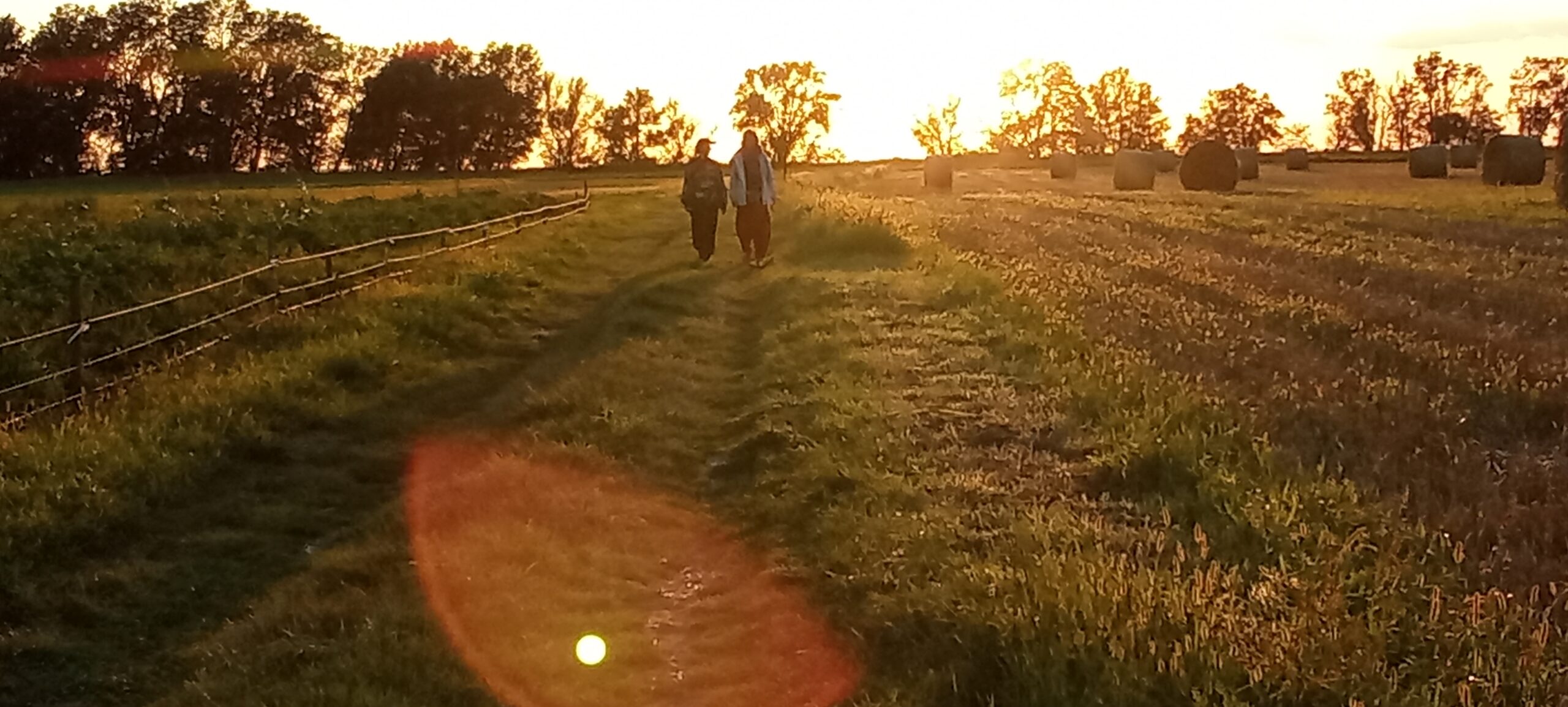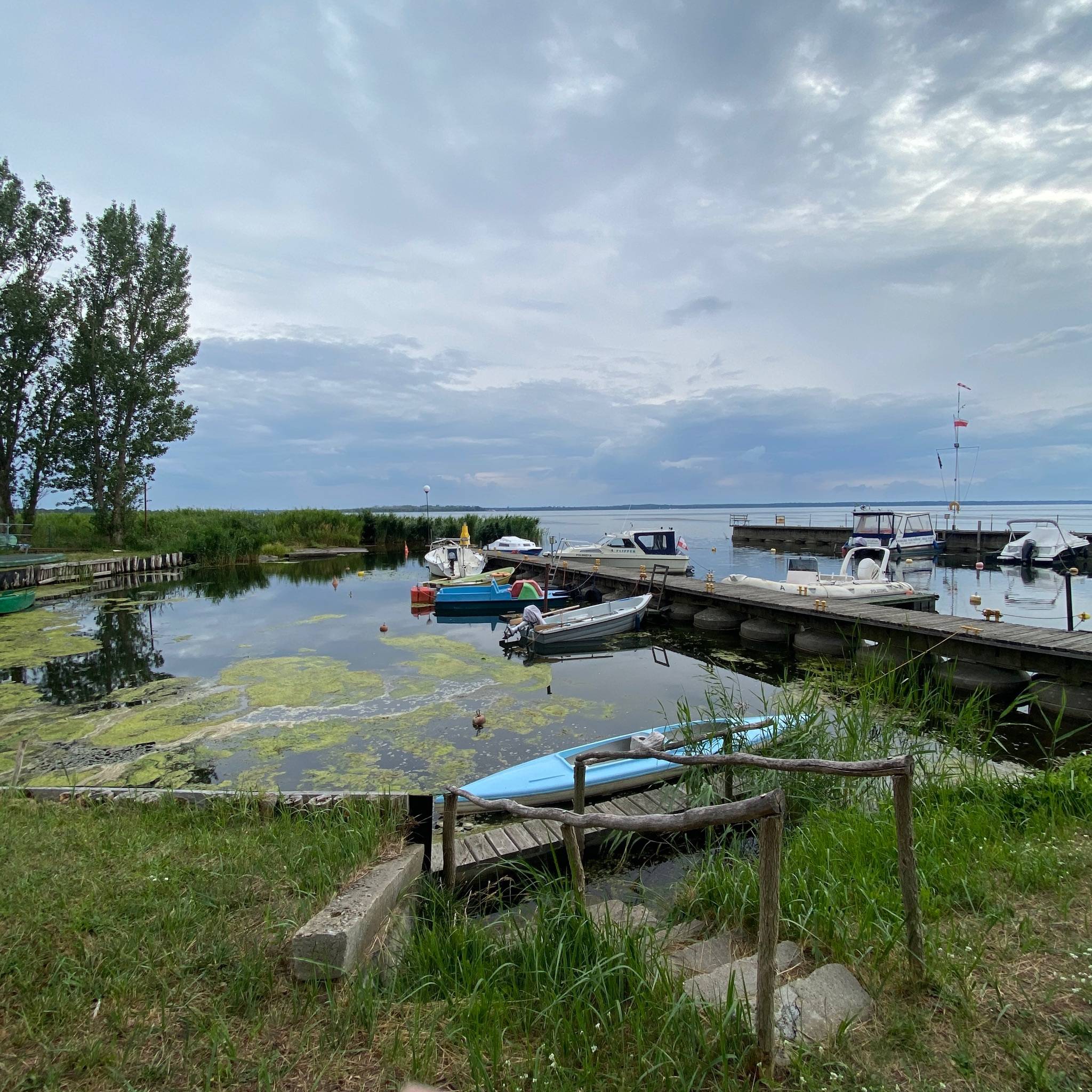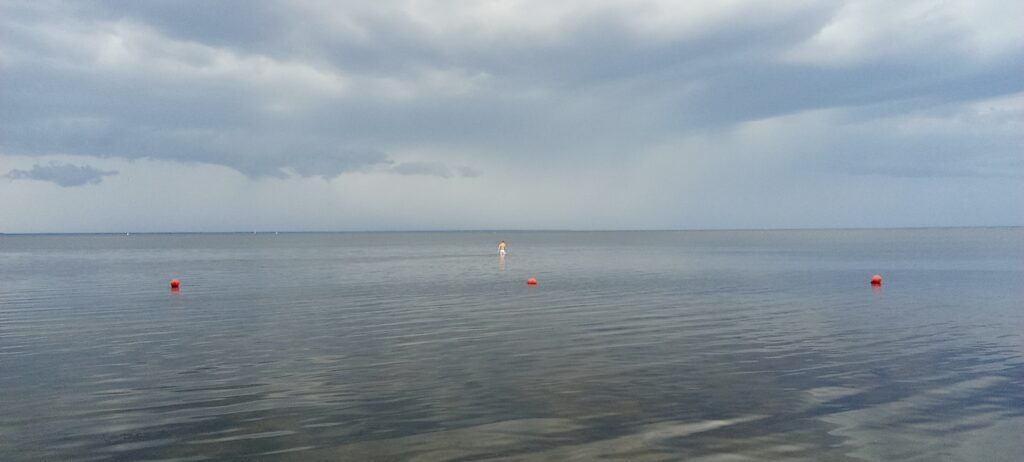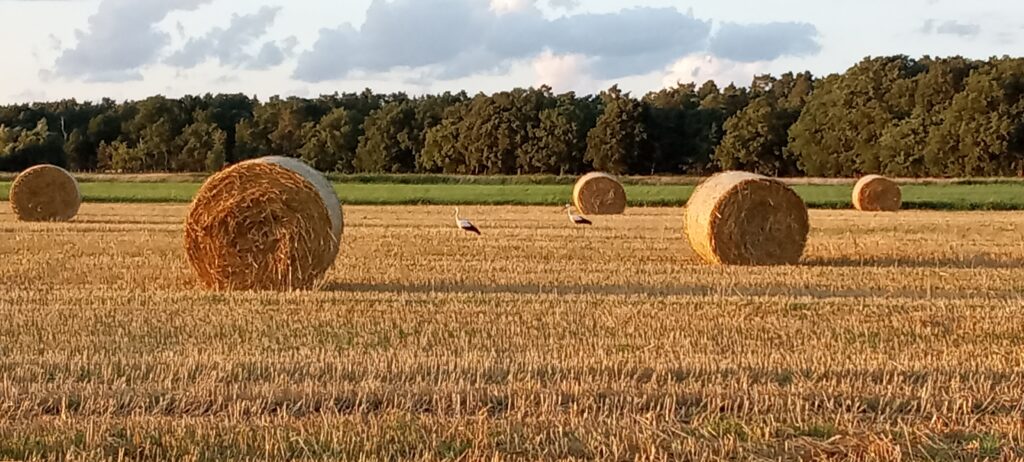The Szczecin Lagoon, situated in the southern part of the Baltic Sea, is a picturesque bay bounded by the islands of Usedom and Wolin. Fed by the rivers Odra, Wkra, and Piana, it boasts a diverse ecosystem and serves as a hub for various recreational activities.
Renowned for its scenic beauty and rich biodiversity, the Szczecin Lagoon is a magnet for tourists, offering numerous marinas, pristine beaches, and vibrant water tourism opportunities. The region is home to several protected areas, including the Wolin National Park and the Natura 2000 sites of Ujście Odry and Zalew Szczeciński, Wolin and Uznam. Additionally, nature reserves such as Czarnocin and Białodrzew Kopicki, along with the ecological utility of Łysa Wyspa, underscore the lagoon's significance as a bastion of environmental conservation.
Notably, the Szczecinski Lagoon serves as a crucial habitat for wetland birds, particularly during migration and wintering seasons, making it one of Poland's foremost avian sanctuaries.
Traversed by the Polish-German border, the lagoon is geographically divided into two parts, each hosting a cluster of seaports. On the Polish shore, ports like Trzebiez, Stepnica, and Nowe Warpno facilitate maritime trade and tourism, while counterparts such as Kamminke, Mönkebude, and Ueckermünde dot the German coastline.
Sailing enthusiasts flock to the Szczecin Lagoon, drawn by its favorable winds and scenic vistas. International sailing regattas, notably in Kamień Pomorski, add to the allure of this maritime playground. Small marinas along the shoreline cater to yachting aficionados, with charter services available in Trzebiez and Świnoujście. Moreover, the lagoon often serves as a launchpad for seafarers embarking on voyages to destinations like Bornholm and Copenhagen.
For land-based adventurers, the lagoon's surroundings offer an extensive network of cycling routes, with the longest stretching over three hundred kilometers. Explorers can encounter a tapestry of historical and natural wonders, including bridges, ruins, lookout towers, Slavic settlements, and ancient trees that stand as living monuments to the region's storied past.
To experience the splendor of the Szczecin Lagoon firsthand, visitors can embark on a virtual tour using the interactive platform provided at https://www.pomorzezachodnie360.pl/.

Kopice
Nestled alongside the Szczecin Lagoon, Kopice boasts a rich history as a once-thriving village complete with schools, a lodge, mill, and windmill. Despite enduring significant destruction post-World War II, Kopice today maintains its tranquil allure. Visitors can discover its small harbor, a picturesque cemetery, expansive dunes, and a pine forest leading to a stunning beach. The area also hosts a nearby bird sanctuary with wild horses, adding to its natural charm. Prior to 1945, Kopice thrived as a bustling village, boasting a population of over 4000 residents and offering direct ferry access to Szczecin. Its economy revolved around agriculture, fishing, and maritime activities, with a vibrant community of sailors calling it home. Renowned for its invigorating sea air and the therapeutic properties of its sandy dunes and pristine waters, Kopice earned the moniker of a seaside resort, or "Haffbad" in German. However, the village's idyllic existence was abruptly interrupted in 1945 when the Red Army marched through Köpitz en route to Berlin during the final throes of World War II. In the ensuing conflict, nearly 90% of the village lay in ruins, signaling the end of Köpitz's era and the birth of a new chapter for Kopice. Exploring Kopice is made easy with numerous cycling routes that wind through the village, showcasing bridges, ruins, Slavic settlements, and towering natural monuments. Additionally, Kopice lies along the marked green Stepnicki hiking trail (Stepnica – Wolin) and the green International Cycling Trail encircling the Szczecin Lagoon. The signposted green Stepnicki hiking trail and the International Cycling Trail around the Szczecin Lagoon pass through the village of Kopice, offering outdoor enthusiasts ample opportunities for adventure. For those seeking to venture further, the nearest Baltic Sea beaches are a mere 45 kilometers away. For more detailed information on cycling routes and exploration opportunities in Kopice, visit the cyclists' website at https://rowery.wzp.pl/en.
Today, Kopice exudes a tranquil ambiance, offering solace amidst its scarred past. Yet, within its quiet confines, treasures await discovery:
The Seven Wonders of Kopice
1. The Marina
Explore the enchanting Kopice Marina, which invites maritime enthusiasts to embark on a boating adventure. Located just 200 meters from Nowa Szkoła, this nautical haven is a picturesque gateway to the waterways. Immerse yourself in the tranquil beauty of Kopice Marina, a perfect starting or landing point for those seeking the allure of boating in this idyllic setting. With its strategic proximity to Nowa Szkoła, the marina serves as a seamless extension of the cultural and artistic center, providing a harmonious blend of natural tranquility and creative inspiration.
Near the marina, there is a campsite and our neighbor Latarnik.pl (https://latarnik-kopice.pl/en) provides cycling trips between Kopice and Trzebiez, canoe rentals and excursions, and boat trips. You can also learn how to steer and maneuver a sailing yacht.
Kopice hosts an annual event called the Kopice Triathlon . Competitors compete in the following events: canoeing on the Szczecin Lagoon, cycling in a forest area and air rifle point shooting.

2. Northern Cemetery
Adjacent to Nowa Szkoła lies the northern cemetery, one of two former burial grounds whose remnants have been preserved. The cemetery adjacent to the church vanished after 1945 along with the remnants of the burnt church. It is presumed that the northern cemetery was also closed, although a chapel stood here until the 1950s, when it was demolished. Today, there are scant tombstones remaining, many repurposed or used as decorations in various gardens. Only the avenue of lime trees and a few remnants of 19th-century graves, painstakingly collected and restored to their original locations by Tomasz Trela, serve as testament to the existence of the northern cemetery. In 2016, the residents of Kopice diligently cleaned the cemetery and placed it under protective measures. Upon completion of the volunteer effort, a sign was erected, providing a brief history of Kopice in three languages
3. Dunes
The gray dune complex, spanning the Szczecin Lagoon between Kopice and Czarnocin, is designated as the Krzewina Nature and Landscape Complex, affording it legal protection. Adjacent to the school lies an inland dune known as "Mount Sinai." Historically, prior to 1945, individuals sought healing in Kopice by immersing themselves in the warm sands of Mount Sinai. These therapeutic warm sand baths, also referred to as Psammo Therapy, were revered for their efficacy in alleviating joint pain, muscle stiffness, and providing grounding and stress relief. Additionally, it is believed that the dune fosters a microclimate conducive to lung health.
An educational trail, marked with wildlife information boards, winds its way along the dunes from Kopice to Czarnocin. The trail traverses through forests, past several untamed beaches, and culminates at the beach in Czarnocin, offering visitors a comprehensive exploration of the diverse ecosystems and natural beauty of the region.
4. The Czarnocin Bay
Located in the neighboring village of Czarnocin to the north, the Czarnocin Bay stands out as one of the most picturesque bays in the region. Spanning almost 200 meters in length, its pristine white sandy beach is nestled within an ancient pine forest, providing a perfect blend of sun and shade. The lagoon boasts sufficient depth for swimming, and during the summer months, visitors can take advantage of a surfboard rental service and an active water recreation school. Accessible via a leisurely half-hour walk or a quick 10-minute bike ride from the school, this beach offers an ideal retreat for relaxation and aquatic enjoyment.

5. Szczecin Lagoon nature reserve
The Szczecin Lagoon Nature Reserve is conveniently located just a ten-minute bicycle ride from the New School. Encompassing over 4,000 hectares of verdant landscapes including forests from the Goleniowska Forest, meadows, pastures, and the pristine waters of the Szczecin Lagoon, this area is designated as a NATURA 2000 site. One of the main attractions within the reserve is the presence of Polish ponies and Scottish Highland cows, introduced to serve as "living mowers." Their grazing activities not only promote vegetation diversity but also create habitats conducive to various animal species, particularly birds, which benefit from the mosaic of green spaces for feeding.
Exploring the reserve can be done on foot, by bicycle, or even on horseback, as motorized vehicle access is restricted. However, visitors can utilize the car park located at the entrance to leave their vehicles. Recognized as a haven for avian life, the reserve is renowned as a "bird paradise" and is a popular destination for birdwatching enthusiasts eager to observe the diverse array of bird species thriving in this natural sanctuary.
6. Kiosk
Many Polish villages feature a local grocery chain known as Zabka. These mini-markets, often similar in size to convenience stores, offer a variety of everyday groceries. Zabka has largely replaced the kiosks that were prevalent during the socialist and post-socialist eras in Polish villages. Following the year 1980, kiosks transitioned from state ownership to private ownership. Initially, they remained significant for smaller communities, serving as hubs for local community engagement, information exchange, and socializing. These kiosks were not merely retail outlets but vibrant social centers that formed an integral part of local life. In Kopice, however, no kiosk remains; the building stands empty and dilapidated. The question of whether the small kiosk can be salvaged remains unanswered, but the need for a local supply of goods persists. Plans involve either renovating the kiosk and operating it as a self-service shop featuring local food producers and a small café during the summer, or integrating the concept into Nowa Szkoła. Yet, as long as the kiosk stands, it serves as a reminder of another era. These memories deserve recognition through collection and preservation.
7. Storks' Nests
Szczecin prioritizes the protection of the white stork species, implementing various initiatives to support their nesting habits. Alongside efforts to restore natural and semi-natural habitats conducive to their presence, measures are taken to facilitate nesting for these birds. One such initiative involves constructing artificial platforms equipped with nesting baskets, which storks readily utilize as a base for nesting. In Kopice, the results of these conservation efforts are evident! Throughout the summer, visitors can observe stork families up close, thanks to the successful implementation of these measures.

Overview of Website Links:
Virtual Tour of the Szczecin Lagoon
https://www.pomorzezachodnie360.pl/
Cycling Routes and Exploration Opportunities
https://rowery.wzp.pl/en
Hiking Zalew Szczecinski
https://www.komoot.com/guide/
Canoeing Adventures in Pomerania
https://discoverpomerania.pl/kajaki/
Sailing and Surfing Opportunities
https://www.ostseehaus-polen.de/en/freizeit/sailing-surfing.html
Marinas and Harbors Guide
http://kotwica.szczecin.pl/mariny-i-przystanie/
Angling Resources in Szczecin
https://pzwszczecin.com/
Tours at the Szczecin Lagoon for All
https://technikgeschichte-in-pommern.eu/en/tours-at-the-szczecin-lagoon/